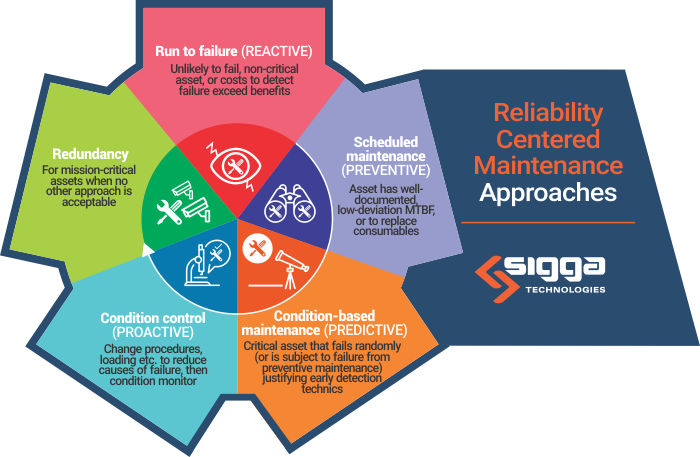How to Improve Enterprise Asset Management with Reliability Centered Maintenance
May 24, 2021Effective Enterprise Asset Management isn’t just about metrics and measures. While things like wrench time and mean time to repair are indeed critical, it is also about having a strategic approach to drive your maintenance program in the right direction. Here’s where Reliability Centered Maintenance (RCM) should be considered.
As a corporate-level strategy, RCM is focused on keeping machinery and assets up and running at maximum capacity while minimizing maintenance costs. Organizations that use RCM carefully analyze assets to identify and predict potential problems so they can set up a fully optimized maintenance approach for each.
RCM is the next level of preventive maintenance, with the maintenance approach carefully tailored to each asset type, ensuring that downtime is minimized at the lowest cost possible. In this article, we’ll give you an overview of RCM, the challenges you might face, and how to start implementing the strategy.
What You Should Know About RCM
The primary objective of RCM is the preservation of systems functionality. The RCM approach is to focus on identifying the conditions that could potentially result in downtime and then prioritizing failure modalities from a maintenance cost standpoint. With this data, operations can decide what specific actions provide the best return on maintenance spending to prevent those failure modalities from manifesting themselves.
What differentiates RCM from preventive maintenance, for instance, is that RCM goes beyond simple scheduling of maintenance at regular intervals. In some cases, it may make sense to invest in triggers to determine when an asset is going to fail, and in other cases, you might decide that the most cost-effective option is to let the asset run to failure.

The best maintenance programs don’t waste resources, and RCM seeks to eliminate waste on things like regularly replacing parts that fail randomly when they may have a much longer useful life or spending a lot of time fixing something that would cost less just to replace.
Adopting an RCM strategy also means instilling a continuous improvement mindset within your maintenance operations, seeking to be more cost and time-efficient year over year.
Challenges to Implementing RCM
While reliability-centered maintenance may take some time and effort to initially implement, it’s well worth the future cost savings and added asset uptime. The first challenge that most organizations face is defining where to start. Implementing an RCM approach across all your assets and facilities would be too daunting, so start with your mission-critical equipment.
The second hurdle is conducting a thorough evaluation of the assets you’ve chosen. You may have never completely brainstormed every possible way in which a piece of equipment might fail, the likelihood of each failure modality, and how much each modality impacts your maintenance costs. However, a thorough analysis is crucial for RCM implementation.
Finally, choosing the right maintenance approach by asset or subsystem and then executing the different strategies can be a hurdle. You’ll need to prioritize the assets and failure modalities you’ve previously identified and then identify how you will modify planning & scheduling tasks to make sure technicians with the right skill sets are being deployed to conduct condition monitoring or preventive tasks by asset type as prescribed by the plan.
Ways to Better Implement RCM
Thankfully, there are strategies you can employ to streamline the implementation of RCM within your company. First, you’ll want to capture machine data on a continual basis to better understand failures and what potentially could trigger those failures. Keep data digital as much as possible, whether it be housing sensor information in a database or enabling technicians with mobile devices and tablets to complete rounds digitally.
That means providing technicians with apps that make it easy to record readings and enter notes with a pull-down menu triggered by a “must input” data field before closing a work order to ensure the capture of asset condition data.
You’ll also want the capability to systematically execute various maintenance approaches by individual assets. This comes from using the data you’ve analyzed and collected to be codified into the execution of planning, scheduling, and maintenance processes. You’ll want to append work orders with the right set of tasks and well-documented procedures for each piece of equipment so service takes place at the appropriate intervals or based on a condition change. Automation software solutions can help prioritize maintenance tasks based on the strategy for each asset or subsystem.
This is where you will begin to see a substantial return on investment (ROI) with RCM. When technicians are employed on a dynamic basis — rather than rigidly predetermined intervals — you’ll enhance metrics like wrench time and equipment downtime. In addition, you will reduce maintenance costs and improve the lifetime of your assets.
How Sigga Can Help with RCM
Sigga solutions can play a pivotal role in the implementation of an RCM strategy. Our Mobile EAM solution helps technicians accurately capture the data you’ll need for analysis, allowing you to create custom, mandatory inputs to capture and structure the condition data for your evaluation of failure modalities on your critical assets.
The Sigga Planning and Scheduling solution can minimize the odds that your technicians will miss the planned RCM maintenance jobs. Increased schedule compliance and improved technician wrench time will ensure your condition-monitoring and preventive tasks get accomplished. You can also automate the creation of schedules that will systematically prioritize maintenance tasks for each group of assets or individual machines based on your RCM strategies.
RCM is all about customizing your planning, scheduling, and maintenance processes to address the most likely failure points of each piece of equipment. By implementing RCM with the right data capture and analysis technologies, you’ll keep your assets up and running a greater percentage of the time while incurring lower costs to your overall maintenance operations.
